Last Updated on: 20th August 2024, 08:28 pm
Though the Khmer Empire lasted for several hundred years, we only have one single firsthand account from a foreign visitor. When the Chinese diplomat Zhou Daguan visited in the year 1296, Angkor Thom was still a thriving, vibrant and wealthy capital. And today, visitors can easily retrace Daguan’s steps, seeing everything from the monumental temples he describes in his memoir to the forbidden Royal Palace area. During your time in Angkor, it’s worth dedicating an entire day of your trip to see as much of the walled city as you can.
By this point in my travels, I’d visited most of the major sites around the Angkor Archaeological Park in the back of a tuk-tuk, and had already grasped the general scope of the area. Therefore, from central Siem Reap, I decided to ride over and explore Angkor Thom entirely by bicycle. This turned out to be the ideal way to get around, as it allowed easy access to some of Angkor Thom’s most secluded and overlooked hidden gems. On more than one occasion, I was surprised to find myself completely alone.
You can see the sites around Angkor Thom in any order you please, but the itinerary below takes the position of the sun into account. Follow the order outlined below to see things in their ideal lighting conditions.
Through the Eyes of Zhou Daguan
As mentioned above, Zhou Daguan was a Chinese diplomat who visited Angkor in 1296. This was well after the reign of Jayavarman VII, the last great Khmer king who fortified the walls of Angkor Thom and built its central Bayon temple. While the Khmer may have stopped building after his reign ended in 1218, Daguan’s writings tell us that Angkor was still thriving in the late 13th century.
While the exact purpose of Zhou Daguan’s trip remains unclear, he did so on behalf of the ruling Yuan Dynasty, or the Mongol Empire which controlled China at the time. According to Daguan, there were already quite a few Chinese living full-time in Angkor then, but as far as we know, none of them left any writings.
Considering how Daguan spent a year there, his work is surprisingly brief. Nevertheless, it’s become an extremely important source for researchers looking to learn more about Angkor’s main monuments, as well as the daily life of the commoner. Zhou Daguan’s memoir is also well worth reading as a traveler. The sense of awe and wonder he experienced when seeing the Angkor temples is something still felt by tourists today.
Throughout the following guide, we’ll be displaying select quotes from Daguan’s memoir as translated to English by Peter Harris.
The South Gate
I rode past Angkor Wat and made my way to the walled city, coming from the south. Already, I’d come face to face(s) with one of the old capital’s most brilliant displays of public art.
On either side of the bridge leading to the city are a team of devas (gods) and asuras (demons) pulling half of a naga serpent. The scene represents the ‘Churning of the Ocean of Milk‘ one of the most famous myths from Hindu cosmology.
"On either side of every bridge there are fifty-four stone deities. They look like stone generals, huge and fierce-looking."
And then atop the gate itself are faces looking every which way. To this day, it’s hard to tell if the faces represent a compassionate Buddhist divinity, or the watchful eye of the king himself. According to Zhou Daguan, this tower was once painted gold.
The Bayon

By this point in my travels, I’d already ridden past the Bayon a number of times, but resisted the temptation to visit until now. I’d been visiting all the major temples in chronological order, but it was now finally time to go and check out Jayavarman VII’s iconic state temple.
I hopped off my bike and eagerly approached the dozens of face towers which seemed to be watching over the entire walled city. As stunning as the Bayon is to look at today, Zhou Daguan got the chance to see it when, like the entrance gate, it was entirely painted gold.
'In the center of the capital is a gold tower, flanked by twenty or so stone towers and a hundred or so stone chambers.'






Noticeably missing from the temple are an outer moat and walls. It’s likely, though, that Jayavarman VII intended for the walls and moat of Angkor Thom itself to double as those of the Bayon! Up until the reign of Jayavarman VII, just about every Khmer king built a brand new pyramidal state temple. But after the Bayon was built in the center of Angkor Thom, no successive king would dare try and top it.
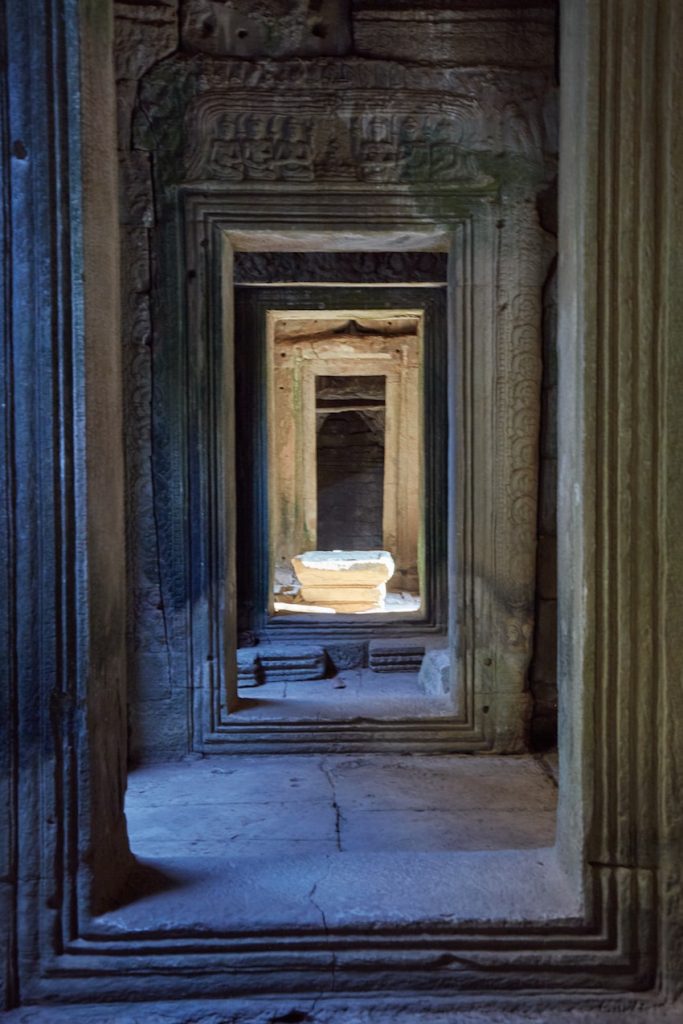





Making your way through the Bayon is disorienting, to say the least. Gone are the wide open spaces of its predecessors like Angkor Wat. Built and possibly rebuilt in several stages, most of the Bayon’s structures are jam-packed together. As you walk through the temple, you’ll find yourself exploring dark corridors and dimly lit chambers, unsure of where they’ll take you next.
Just as with Jayavarman VII’s previous temples like Ta Prohm and Preah Khan, a multitude of different deities were once worshipped here. Today, the Bayon has been converted to a Theravada Buddhist temple, so you’ll encounter Buddha statues from a wide range of styles and eras.


Eventually, I found myself at the top level. In the center stands a large circular sanctuary unlike anything else in Angkor. For some reason, Zhou Daguan does not mention actually entering or ascending the Bayon. Was this part of the temple closed off to the public? Whatever the case may have been back then, I found myself starting to walk more quickly as I noticed several large tour groups making their way over to the temple.
One of, if not the most, defining characteristic of the Bayon are all the smiling faces. In fact, there are over 200 of them! Originally, the towers were thought to represent Brahma, the four-faced Hindu creator god. But once it became clear that the Bayon was a Buddhist temple, experts were left scratching their heads.
The truth is, nobody knows for sure who the faces are supposed to represent. The popular theories, though, are that they’re either Avalokiteshvara, the Buddha, or perhaps they’re even Jayavarman VII himself.


Back down, I took some time to admire the bas-reliefs. Just as many of the carvings at Angkor Wat glorified the military exploits of Suryavarman II, huge portions of the Bayon reliefs are dedicated to the war between the Khmer and the Cham. Jayavarman VII was instrumental in driving out the Cham from Angkor, after which he declared himself king of the Khmer Empire.

One of the reasons Jayavarman VII was successful was because he’d previously spent years living in the heart of the Champa Kingdom. There, he not only obtained an intimate knowledge of Cham society, but as evidenced by the Bayon bas-reliefs, some useful allies as well.
In the reliefs, the Chams are easily distinguishable as the ones with headwear. And at first glance, it all appears as a massive battle between the two sides. Upon closer inspection, however, you’ll notice some Cham fighting together with the Khmer, and even some Khmer fighting for the Cham!
'There are boar fights and elephant fights as well, and again the king invites foreign envoys as spectators.'
Meanwhile, other bas-relief scenes show everyday life in Angkor. Merchants sell goods at a lively market, hunters wait for their prey in the forest, while men even bet on boar and cockfights.
Zhou’s descriptions of Angkor life match up pretty well with the scenes depicted in the reliefs, even nearly a hundred years after they were first carved.



Knowing even a little bit about Khmer society, it shouldn’t come as much of a surprise that there are plenty of religious and mythological scenes amongst the bas-reliefs as well. Scenes from both Hinduism and Buddhism are present, though only a few of the depictions of Buddha have survived.

'Although this is a country of barbarians, they all know at first hand that they have a supreme ruler'
The Royal Terraces
The Royal terraces span around 400 meters in total along a north-south axis. They’re comprised of two sections: the Leper King Terrace and the Elephant Terrace. Situated just outside the private Royal Palace area, the king would sometimes appear here to listen to official complaints. Like everything else at Angkor, the terraces were elaborately decorated. They can be enjoyed from both above or below.
During my visit, I decided to bike all the way to the Leper King Terrace and then gradually walk south. Though you can’t tell from the pictures, in front of the terraces is a large parking lot where you can keep your bicycle, in addition to some food and drink stands.
The Terrace of the Leper King
First of all, the title of this terrace is misleading. As mentioned by Zhou Daguan, there was indeed a legend in Cambodia that a former king (possibly Yashovarman I) had leprosy. Aware of this legend, archaeologists mistakenly identified the sculpture atop the terrace as this former leper king. Basic erosion and discoloration made him appear a little bit like a leper.


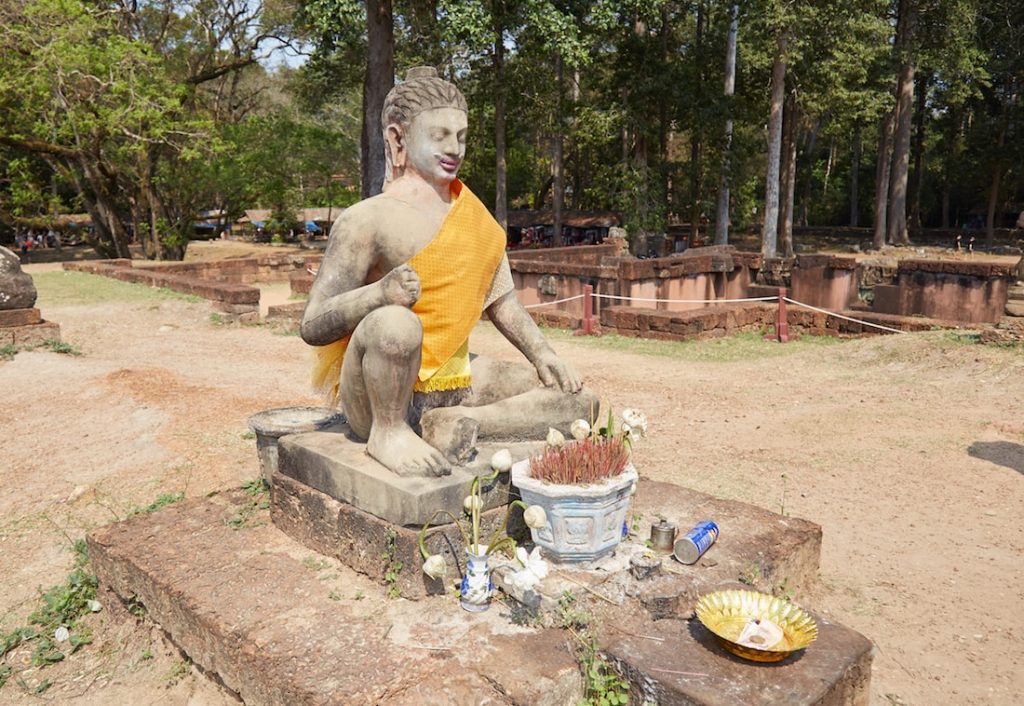
The statue, however, was likely not one of a former king, but probably a god from the Hindu pantheon, such as Kubera or Yama. (The original, by the way, sits in Phnom Penh’s National Museum, while this one is a replica).
The confusing name aside, this terrace features a lot of interesting carvings of a wide variety of characters, divided amongst several rows.
There is even a small little corridor in between two sections of the wall. Currently under restoration, researchers aren’t quite sure whether this was made with a purpose, or if a new portion of the wall was built after an initial collapse. One theory suggests that the terrace even doubled as a crematorium!
'There are a lot of lepers – and local people think nothing of sleeping and eating in their company. . . It is said that a king once contracted the disease, so people are not troubled by it.'
Elephant Terrace
As the name suggests, large elephant trunks descend down from the top of the terrace. Look closely and you’ll even see them spitting out water! Also look for the ‘atlantes’ which seem to be working hard to hold everything up. This must’ve been an inspiration for the decoration at later Thai temples, such as Wat Arun and Wat Phra Kaew. Also look out for a mysterious carving of a multi-headed horse.



The Royal Palace Area
The Royal Terraces lead right into the area that was once home to the Royal Palace. These wooden structures were likely first built back in the 10th century, long before the establishment of Angkor Thom itself. As the structures were made entirely of wood, nothing but the entrance gate and the pond remain today.
The main palace may have been partially visible from a distance, as Zhou mentions long corridors with complicated walkways and tiles made of lead. It was held up by huge pillars carved with Buddha images. But later, he writes that he wasn’t actually allowed in.
The stone gates that lead to this private ‘city within a city’ still remain, while certain Bayon bas-relief carvings may also give us a better idea of how it looked. While the king’s palace would’ve been the most impressive, there also would’ve been plenty of other homes belonging to high-ranking officials as well.
'I have heard that there are many wonderful places in the inner palace, but it is very strictly out of bounds and I could not get to see them.'

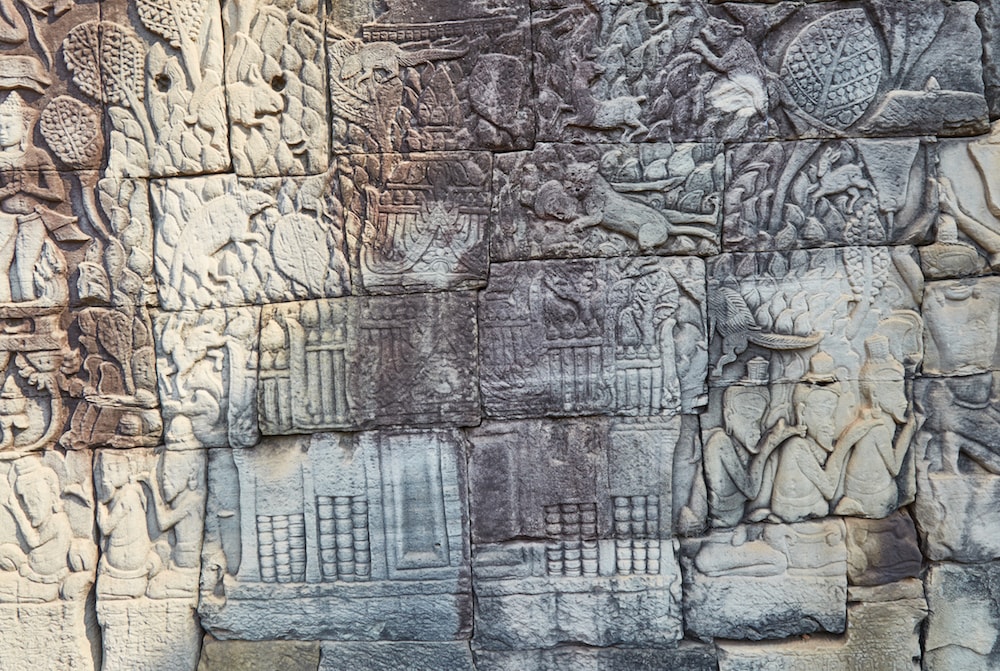
Phimeanakas
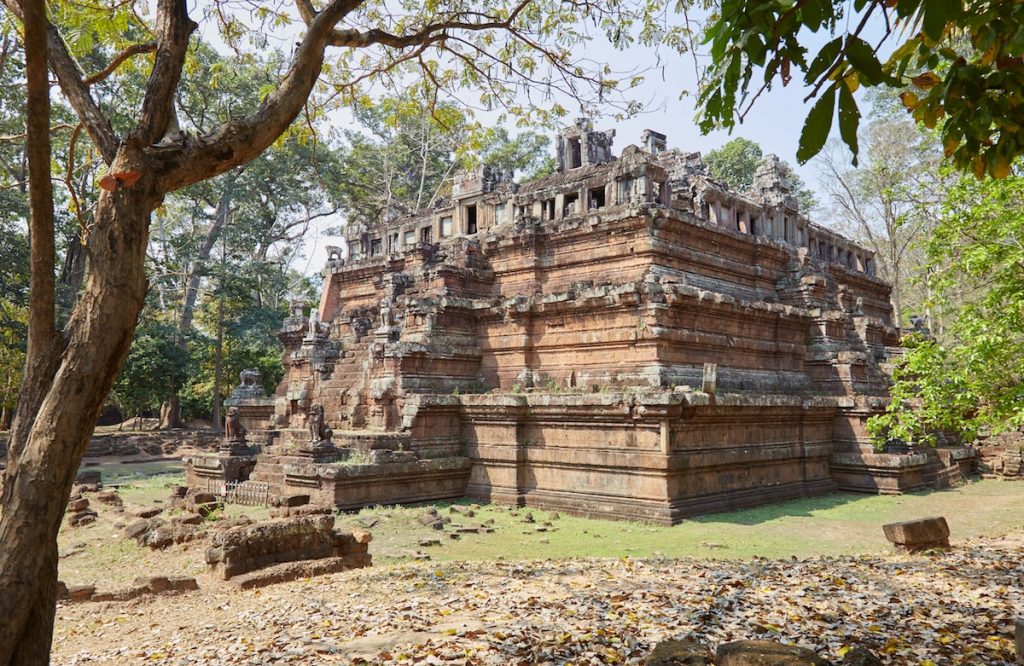

Phimeanakas functioned as a private temple for the king. It may even be one of the oldest structures at Angkor, but was renovated and added to by Suryavarman I at the beginning of the 11th century. A couple hundred years later, Jayavarman VII’s wife wrote an inscription on a stele here that detailed his time in Champa and how he’d eventually become ruler.
According to Zhou Daguan, the king would have to come here nightly to make love to a naga (serpent) spirit who’d take on the form of a beautiful woman. According to local belief, if the king failed to do so, disaster was bound to strike the kingdom. Or, if the naga spirit herself failed to show, it meant that the king’s days were numbered.
'Inside the palace there is a gold tower, at the summit of which the king sleeps at night. The local people all say that in the tower lives a nine-headed snake spirit which is lord of the earth for the entire country.'
Royal Pond
The royal pond is a small artificial reservoir behind Phimeanakas. It even features its own wall which is entirely carved with bas-reliefs. While we don’t know for sure, it’s likely that the pond would’ve been for exclusive use by the king, his wives and his concubines.
After all, Zhou Daguan mentioned how Angkor citizens would immediately run to a body of water after making love. (Given the ancient Chinese views on bathing, Daguan was also convinced that this was the reason for many illnesses such as leprosy.)
As a tourist today, the area is secluded and peaceful, as there’s no way for any tour vans to ride right up to it. Try walking along the wall to get a good view of the carvings, but be careful not to fall in!



Baphuon




The Baphuon was commissioned around the year 1060 by King Udayadityavarman II as his state temple. At the time, it was one of Angkor’s most ambitious ever projects. And even over 200 years later, this was the temple that Zhou Daguan was most impressed with during his visit to Angkor. Sadly, though, much of the temple had collapsed by the 20th century, and it needed to be almost entirely rebuilt. The temple only opened up for visitors as recently as 2011.
If you’re seeing the Angkor temples in chronological order (see the end of the article), you would’ve already visited both Phimeanakas and the Baphuon. I already had before as well, but still enjoyed having a second look.
'About a li north of the gold tower there is a bronze tower. It is even taller than the gold tower, and an exquisite sight.'
The Preah Pitus
The group of temples known as the Preah Pitus are probably the most overlooked temples in Angkor Thom. Due to the lack of inscriptions, nobody’s really sure of who built them or when. But some scholars think they may be among the very few temples built after the reign of Jayavarman VII
The group of 5 temples, unimaginatively named ‘T’ through ‘Y’ is also one of the quietest areas you’ll encounter in all of Angkor. I found myself completely alone at all 5 temples, despite the Royal Terraces being a stone’s throw away. That alone made them well worth the visit, and it was one of the highlights of my day in the walled city. If you’re short on time, the most interesting temples are U and X.
U

Temple U consists of a single prasat on a raised platform. The lintel carvings are the main highlight here. You’ll see a multi-armed Shiva along with another depiction of the ‘Churning of the Ocean of Milk.’

X

Preah Pitu X is the biggest of the bunch. Standing on a large base, it’s almost like its own miniature ‘mountain temple.’ The Buddha images here remain completely intact, a pretty clear indication that ‘X’ is among the most “recent” Angkorian temples. It must’ve been built after the Hindu reactionary iconoclasm which followed Jayavarman VII’s reign.

T

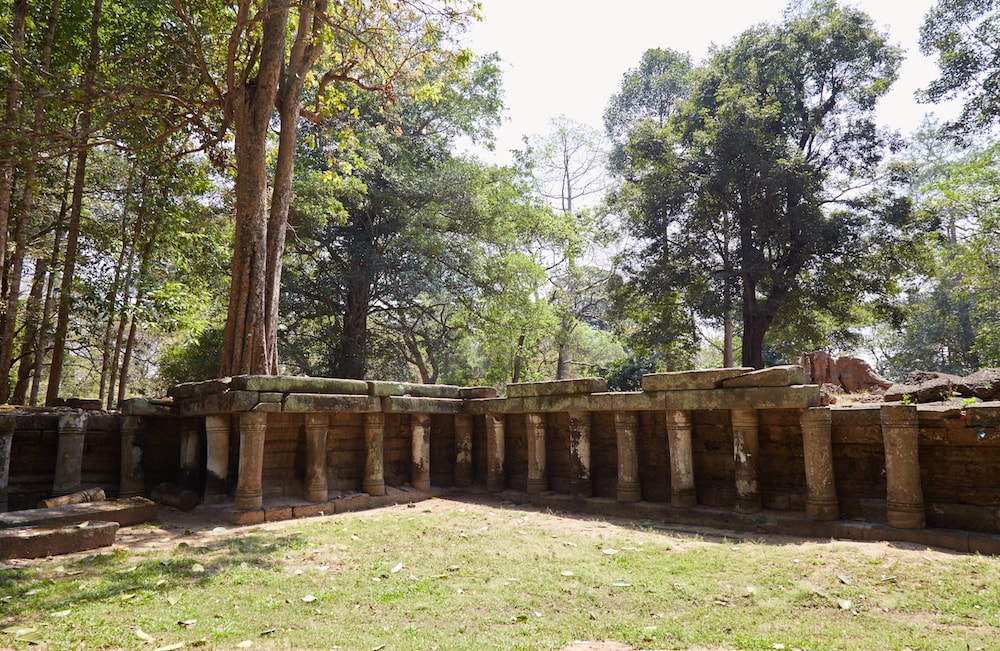
‘T’ is a rare west-facing temple that even has its own elevated Naga balustrade. Again, the single cruciform-shaped sanctuary sits on a small pyramidal base.
V

One of the larger Preah Pitus, with a well-preserved Shiva linga at the center of the main prasat.
Y

‘Y’ is worth a visit for its carvings depicting the god Vishnu as well as scenes featuring his avatars, Rama and Krishna.
The North Gate
The North Gate is, or at least was, a mirror image of the South Gate mentioned above. The exact same ‘Churning of the Ocean of Milk’ story is depicted here, although the statues have been left unrestored. Since Siem Reap lies to the south of Angkor Thom, it’s understandable why that gate receives most of the traffic.
The North Gate, while in much worse condition, is worth checking out if you want an unobstructed view of the sculptures without any visitors in the way.



The gates 'shut at night and open early in the day. There are guards, too, though only dogs are not allowed in – and also criminals who have had their toes amputated.'
Tep Pranam
There’s not a whole lot left of Tep Pranam today, but it’s worth a quick look as it’s situated right before our next destination, Preah Palilay.
Tep Pranam consists of a long naga balustrade, which leads to a small platform containing a large seated Buddha image (in the ‘Calling the Earth to Witness‘ posture.) The statue was probably placed here long after Angkor Thom’s heyday, as the presence of sema stones indicate that a wooden Theravada Buddhist ordination hall once stood here. A large standing Buddha can also be seen nearby.


Preah Palilay
Preah Palilay is a small temple consisting of a tall and narrow sanctuary tower. While not especially impressive compared to all of the other amazing temples in Angkor Thom, it’s notable for its unique shape. The temple also happens to be off the tourist trail, and is worth a stopover for those looking to escape the crowds.
The temple features both Hindu and Buddhist imagery. As the Buddha images have been left intact, some experts believe that along with the Preah Pitus, it may also be among the very last stone structures built at Angkor.
The Khleangs
The Khleangs, located within the walled city of Angkor Thom, on either side of the road to the Royal Palace, remain an enigma. While the word khleang translates to ‘storehouse,’ nobody is really sure what purpose these structures once served. Most likely, they were reception halls for dignitaries. Both predate the establishment of Angkor Thom, each having been built by two different kings from the late 10th to early 11th centuries.
North Khleang



South Khleang



Prasat Suor Prat
The towers collectively known as Prasat Suor Prat are yet another unsolved mystery of Angkor. They likely weren’t temples. But then why would they be built of stone? Even the Royal Palace, the residence of the king, was made of wood. The only information we have to go by is the description by Zhou Daguan, an insight that’s both fascinating and chilling.



Supposedly, the twelve stone towers were built as places to settle disputes. When nobody could determine who was right and who was wrong, Angkorian families would leave it up to divine judgement.
Two individuals would occupy a stone tower, with their families on guard outside. If one of the people developed something like sores, a cough or a fever, he would be judged the guilty party! The innocent person, on the other hand, would emerge completely healthy.
"They may sit in the towers for a day or two, or for three or four days. Then for sure the one who is in the wrong becomes visibly ill, and leaves."



Vihear Prampil Loveng
The shrine known as Vihear Prampil Loveng is almost completely unknown to tourists, but local Cambodians regularly visit to make offerings. The shrine is significant because the Buddha statue on display is none other than the original main Buddha statue of the Bayon.
The statue was originally discovered in pieces within the chamber underneath the temple’s central sanctuary. It’s generally believed that it was destroyed during the iconoclastic period after Jayavarman VII’s reign. Another interesting find, however, was an Ayutthaya-style Buddha image amongst the same pile of rubble. While Ayutthaya took over and occupied Angkor in the year 1431, why was that later Buddha broken and thrown into the same pit?
We may never know the answers, but Vihear Prampil Loveng is at least worth a quick peak to see the statue that once sat at the very heart of an empire.


Back to the Bayon
The Bayon is such a magnificent temple that before calling it a day, I had to go back and take another look. As with Angkor Wat, the Bayon is worth visiting multiple times in different lighting conditions. The early evening, just as the tour groups are finishing up, is just as ideal as the early morning.
But even after starting my journey back to Siem Reap, I had a hard time pulling myself away, continually stopping to appreciate it from new angles. The Bayon is a sight that has stuck in the minds of many visitors over the years, and will continue do so for centuries to come.



"I suppose this all explains why from the start there have been merchant seamen who speak glowingly about 'rich, noble Cambodia.'''
Additional Info
People exploring the Angkor temples will need to base themselves in the city of Siem Reap. The city is easy to get to, being served by a wide variety of Asian airlines. You can fly direct from cities like Bangkok, Hong Kong, Singapore and Kuala Lumpur. Of course, you can also fly domestically via Phnom Penh.
Generally, you want to avoid coming by bus from Thailand. Many of the vendors of these tickets are in on some kind of scam. There are no true direct buses, as you will always have to go through immigration at the border. I did the trip the opposite way, from Cambodia to Thailand, without any problems, but there are certainly a lot of seedy characters in the area.
Siem Reap is reachable by bus from many other parts of Cambodia. However, I wouldn’t ever want to ride a night bus, as many of the roads in the country are absolutely horrible. You want to make sure your driver has full view of all the potholes on the roads.
The best way to get around the Angkor Archaeological Park is to hire a tuk tuk. Unlike the tuk tuks in Thailand, these are basically special wooden carriages attached to a motorbike. The ride is bumpy, but definitely more comfortable than riding on the back of someone’s bike.
The standard price is generally $15 per day. Air conditioned cars can be hired for a higher price, usually around $40 per day.
Foreigners aren’t allowed to rent motorbikes in Cambodia but you can rent a bicycle from your hotel. It’s possibly to bike to Angkor Wat and Angkor Thom by bicycle, though I wouldn’t recommend it for anything more distant than that.
The perfect amount of time to see the major temples in order is 5 days. This requires purchasing a seven-day pass. At $72, it’s only $10 more than the three-day pass, so it’s still a good deal even if you don’t use all the days.
There is no need to join an organized tour to visit the temples in order. What you do need to do is find a reliable tuk-tuk driver (they can also be arranged through your hotel) who understands exactly what you want to do. As most tourists only want to see the most famous temples over the course of one or two days, the driver might be a little confused at first by what you’re suggesting.
It doesn’t make the most sense logistically, but after having done it myself, I couldn’t picture exploring the temples any other way. Just give yourself enough time in Angkor and the plan below is perfectly feasible.
The following plan is largely based off the suggestion given by Michel Petrotchenko in his excellent book Focusing on The Angkor Temples: The Guidebook. Now after having done it myself, I’ve added a few small additions and minor alterations.
Pre-first day: Buy your entry pass to the ruins the day before in order to avoid having to wait in a long line the next morning. It’s only possible to do so from 5pm the previous evening. Most lines can get very long, but luckily, the booth for the seven-day passes will have almost no one waiting in them! You can kill time before 5pm hanging around Siem Reap and visiting the Angkor Museum.
Note: The standard price for a day around the ruins via tuk-tuk is around $15. However, you will be asked to pay a little bit extra for going to out-of-the-way places like the Roluos group and Banteay Srei. You will also be expected to pay a little more to include a sunrise or sunset in your schedule.
First day: Head straight to the Roluos group (Preah Ko, Bakong and Lolei).
Back in the main Archaeological Park, walk up the hill to see Phnom Bakheng around lunchtime.
Nearby are a few unique temples called Baksei Chamkrong and Prasat Kravan that both date from the early 10th century.
Second day:
Start the day off at East Mebon, and then Pre Rup. Then head north to Banteay Srei.
(Note: A visit to Banteay Srei can also be combined with a trip to the river carvings of Kbal Spean. Therefore, you may choose to deviate from the chronological order slightly by visiting Banteay Srei, Kbal Spean and then continuing on to East Mebon).
After lunch, make a visit to Ta Keo before heading inside the walls of Angkor Thom. Make a brief stop at the North and South Khleangs (one should be enough if you’re short on time).
Still inside Angkor Thom, visit what’s left of the Royal Palace and then Phimeanakas and the Baphuon. You’ll pass by it, but resist the temptation to visit the Bayon just yet.
Third day:
It’s now finally time to visit Angkor Wat. This is one of the few temples to be open for sunrise. However, the temple gets extremely crowded each morning, so you may want to come slightly after the sun has risen to avoid the crowds.
After taking your time at Angkor Wat, head over to Thommanon and Chau Say Tevoda (right across the street from one another). Then, head east to Banteady Samre.
Fourth day:
This will be your first introduction to the temples of Jayavarman VII. Start the day off as early as possible at Ta Prohm. (As an alternative to sunrise and Angkor Wat, check out the sunrise from Srah Srang which is right by Ta Prohm).
Then move on to Preah Kahn. Afterward, check out the smaller temples of Neak Pean, Krol Koh and Ta Som. Finally, end the day at Banteay Kdei.
Fifth day: Head to Angkor Thom and admire the statues of the devas and asuras outside of the South Gate. Inside the walled city, it’s now time to visit the Bayon.
Afterwards, go see the Royal Terraces (the Elephant Terrace and Terrace of the Leper King).
You can also go see Preah Palilay and the Preah Pitus complex, which are believed to be among the final temples in Angkor.
You should still have some time left over in the late afternoon. Consider revisiting the Bayon to see it in a different light, or head back again to Angkor Wat, as the temple faces west and looks best in the evening.
Beyond: If you’re like me and want to make the most of your seven-day pass, here a couple suggestions: You can try visiting some of the smaller, obscure temples (such as Banteay Thom) built by Jayavarman VII which are north of Preah Khan.
On another day, consider heading over to one of the smaller hilltop temples like Phnom Krom or Phnom Bok. Or, just return to the temples you liked best.
Remember, there are still a whole lot of amazing temples outside of the Angkor Archaeological Park, such as Preah Vihear, Koh Ker, Banteay Chmar and more. These will all be covered in their own articles, along with tips on how to visit them all on a three day road trip around the country.
If your main goal is to see the ruins, the closer you are to them the better. There’s not a whole lot to see or do in central Siem Reap other than the Angkor National Museum and maybe some arts and crafts shops. (Of course, there’s Pub Street, if that’s your thing, but it might be a little hard to appreciate the ruins while hungover.)
Understand that you need to purchase your pass before approaching the archaeological site. The ticket vending area is located on Apsara Rd., east of the main road which takes you from Siem Reap to Angkor Wat temple.
There are staff just about everywhere checking for passes, both at the archaeological zone entrances and at all the individual temples, so make sure not to forget it at your hotel. Later in my trip, I practically cycled through a jungle to get to one of the most obscure little temples in the middle of nowhere. And sure enough, there was a staff person there asking to see my pass, before asking how I ever managed to find the place!
As Cambodia can get very hot, be sure to apply sunscreen and wear a hat. Fortunately, there are vendors all throughout the archaeological zone selling water and fresh coconuts. There are also ample places to sit down for lunch.
You want to get started each morning as early as possible. One reason for this is that a large majority of the temples face east, meaning they look best in the morning light. Another reason is that due to Angkor’s massive popularity, the major temples get absolutely flooded with tourists from around 8 or 8:30am. The temples (with the exception of Angkor Wat) open at 7:30, so try to get there right around then.
Things get much quieter in the mid-afternoon when it’s hottest. If you’re able to bear the heat, this is a good time to visit some of the more popular temples, though it won’t be ideal photography wise.

Pin It!




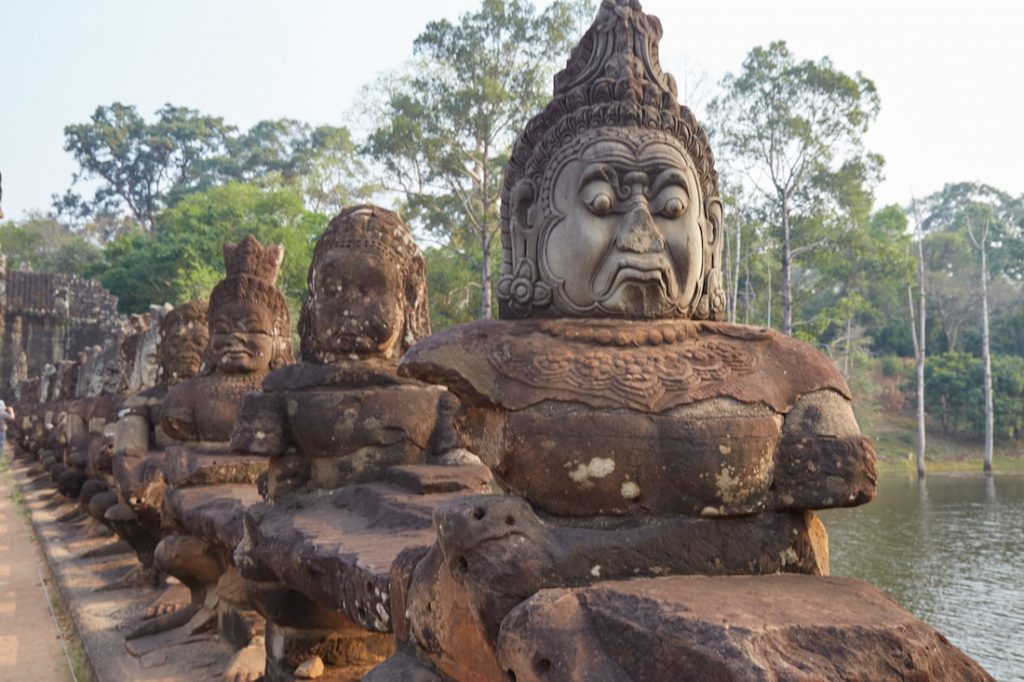











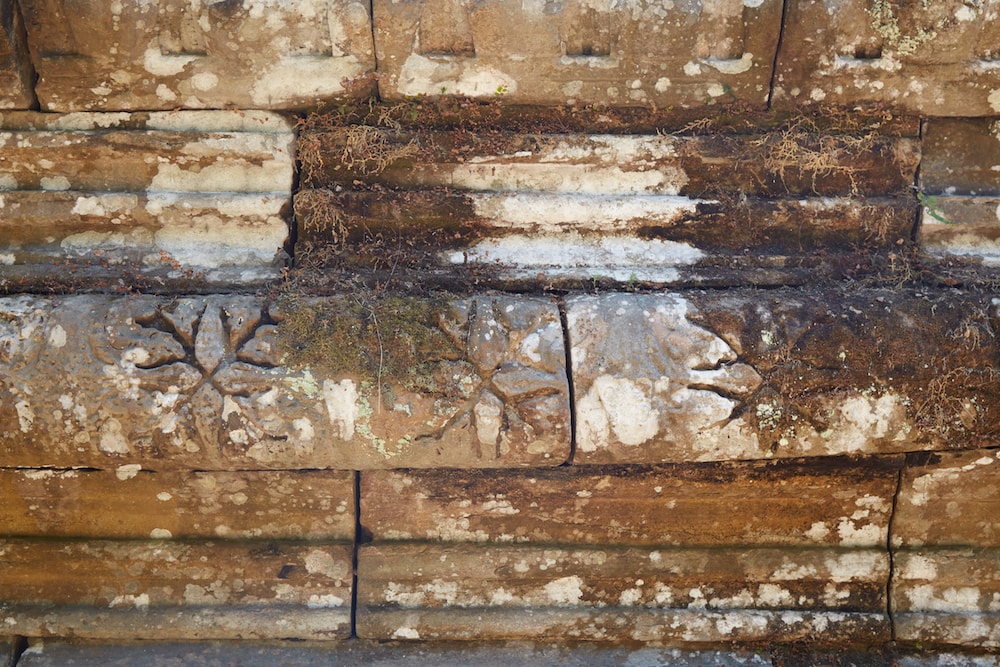





References????
Hi, the main sources are mentioned at both the beginning and the end of the article.